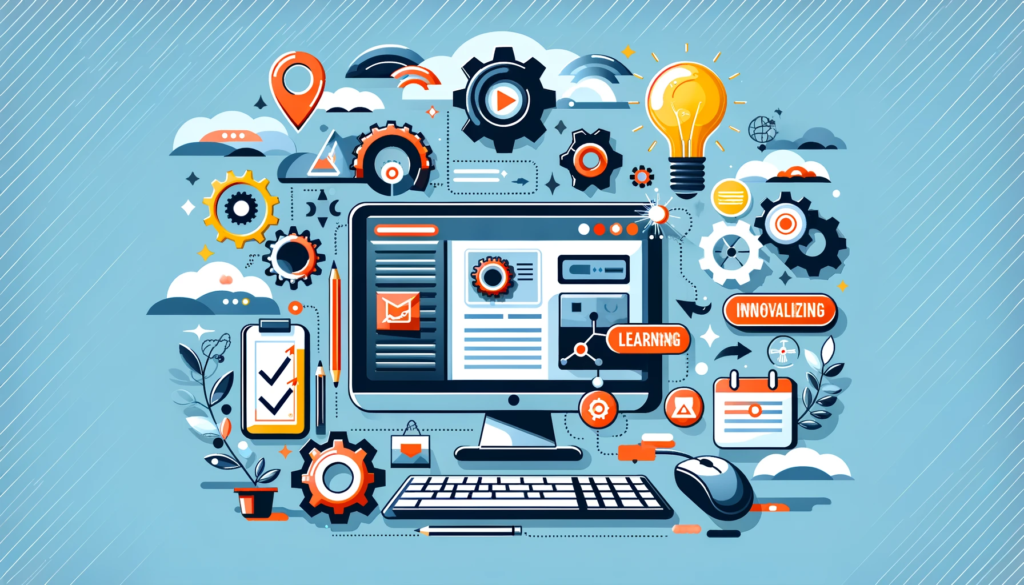
Digital Automations: The New Age Efficiency Booster
In the current age of technological advancements, digital automations are paving the way for unprecedented levels of productivity and efficiency. This section aims to provide an understanding of digital automations and delve into their emergence and evolution.
Table of Contents
Understanding Digital Automations
Digital automations, in essence, are software-configured tasks that execute predefined sequences without the need for human intervention. They leverage technology, including artificial intelligence (AI), machine learning, and robotics, to automate routine tasks, thereby freeing up time and resources.
From scheduling meetings to sorting emails, automating bill payments, or streamlining business operations, digital automations are transforming the way individuals and businesses function. By reducing manual effort and minimizing human error, these automations significantly enhance productivity and efficiency. To explore further about the use of automation in business operations, follow this link.
The Emergence and Evolution of Digital Automations
The concept of automation is not new; however, the advent of advanced technologies like AI and machine learning has significantly elevated its scope and effectiveness. The initial phase of digital automations involved simple rule-based tasks. However, with the evolution of digital automation tools, complex tasks involving decision-making and problem-solving can now be automated.
The progress in the field of AI has been a game-changer for digital automations. AI-powered automation tools are capable of learning from human interactions and improving over time. This ability to self-learn and adapt has opened up new avenues for digital automations, enabling them to perform tasks that were once considered exclusively human.
For instance, AI-powered chatbots can now handle customer queries and complaints, recommend products or services, and even make sales pitches. This is just one example of how digital automations have evolved over time, thanks to the advancements in technology. There are numerous such examples of AI-powered productivity solutions that are transforming personal and professional lives.
In conclusion, digital automations have come a long way since their inception and continue to evolve. By leveraging these technology-driven solutions, individuals and businesses can optimize their tasks, thereby boosting productivity and efficiency. To have a better grasp of technology-driven automation strategies, you can refer to this link.

The Impact of Digital Automations on Productivity
The rise of digital automations has brought about significant changes in both personal and professional lives. In this section, we will delve into how these automations enhance efficiency and examine some successful implementations of digital automations.
How Digital Automations Increase Efficiency
Digital automations, powered by advanced technology and artificial intelligence, can significantly enhance productivity by automating repetitive tasks, thereby saving time and reducing the likelihood of human errors. These automations allow individuals and businesses to focus on more complex and strategic tasks.
For instance, in a business setting, digital automations might be used to automate customer service responses, data entry tasks, or even complex processes like inventory management. By automating these tasks, businesses can save substantial time and resources, resulting in increased productivity and efficiency.
Simultaneously, in a personal setting, digital automations can help manage daily tasks, such as scheduling appointments, managing finances, or organizing emails. By automating these tasks, individuals can free up time for more valuable or enjoyable activities.
Consider the following table, which demonstrates the potential time savings achieved through the implementation of digital automations:
| Task | Time Spent Without Automation (hrs/week) | Time Spent With Automation (hrs/week) | Time Saved (hrs/week) |
|---|---|---|---|
| Data Entry | 10 | 2 | 8 |
| Customer Service Responses | 15 | 5 | 10 |
| Inventory Management | 12 | 4 | 8 |
| Email Organization | 5 | 1 | 4 |
Case Studies: Successful Implementations of Digital Automations
There are countless examples of successful implementations of digital automations across various sectors. In the healthcare industry, digital automations have been used to automate appointment scheduling and patient record management, leading to increased efficiency and improved patient care.
In the finance sector, banks and financial institutions have leveraged digital automations to automate transaction processing and fraud detection, leading to increased operational efficiency and enhanced customer trust.
In the e-commerce industry, businesses have used digital automations to automate inventory management and customer service responses, leading to improved customer satisfaction and increased sales.
These examples illustrate the significant impact that digital automations can have on productivity and efficiency, both in personal and professional settings. For more insights into the implementation of automation in business operations and the potential benefits of ai-powered productivity solutions, feel free to explore our other articles. The next step towards harnessing the full potential of digital automations is learning how to use digital automation tools, which we will cover in the subsequent sections of this article.

Digital Automations in Personal Life
The power of digital automations extends beyond the business realm. They are also transforming personal lives, making day-to-day tasks more manageable and enhancing personal finance management.
Automating Daily Tasks with Digital Tools
Digital automations are being used to streamline a multitude of daily tasks. From setting reminders and scheduling appointments to tracking health and fitness goals, these technological innovations are helping individuals stay organized and efficient.
For example, consider task management. With digital automation tools, individuals can set up automated reminders for important tasks, due dates, and appointments. This not only ensures nothing is forgotten but also saves time that would otherwise be spent manually managing these tasks.
Similarly, health and fitness tracking can also be automated. Digital tools can automatically record daily steps, monitor heart rate, and track calorie intake. This data can be used to set and achieve personal fitness goals.
| Daily Tasks | Automated Solutions |
|---|---|
| Task Management | Automated reminders and task scheduling |
| Health & Fitness Tracking | Automatic recording of daily steps, heart rate, and calorie intake |
For more information on how to leverage digital automation tools in daily life, visit our guide on digital automation tools.
Making Personal Finance Management Easier
When it comes to personal finance management, digital automations are proving to be game-changers. They simplify budgeting, expense tracking, and investment management, making it easier for individuals to stay on top of their finances.
For instance, budgeting can be automated using digital tools that track income and expenses, categorize transactions, and provide real-time updates on spending habits. This not only simplifies budget management but also promotes better financial decision-making.
Similarly, investment management can be automated with digital tools that offer automated investing, portfolio rebalancing, and real-time market updates. This makes it easier for individuals to grow their wealth without needing an in-depth understanding of the financial markets.
| Personal Finance Tasks | Automated Solutions |
|---|---|
| Budgeting | Automatic tracking of income and expenses, categorizing transactions |
| Investment Management | Automated investing, portfolio rebalancing, and real-time market updates |
Embracing digital automations in personal life can boost productivity and efficiency, freeing up time for more meaningful activities. For more insights into how technology can enhance daily life, explore our articles on technology-driven automation strategies and AI-powered productivity solutions.

Digital Automations in Business Operations
Digital automations have become a significant component in the world of business. They streamline operations, improve efficiency, and enhance customer service. In this section, we will delve into the ways digital automations are revolutionizing business processes and customer service.
Streamlining Business Processes
Digital automations have the potential to streamline a wide range of business processes. They can automate repetitive tasks, speed up time-consuming processes, and reduce the likelihood of errors. This leads to increased efficiency and productivity, allowing businesses to focus on more strategic tasks.
For instance, businesses can automate tasks such as data entry, invoice generation, and inventory management, which traditionally require a significant amount of manual work. By automating these tasks, businesses can save time and resources, reduce the risk of human error, and ensure a higher level of accuracy.
In addition, digital automations can also help in project management by automating task assignment, progress tracking, and report generation. This allows for smoother project execution and improved team collaboration.
For more insights into how automation can enhance business operations, visit our article on automation in business operations.
Enhancing Customer Service with Digital Automations
Digital automations play a crucial role in enhancing customer service. Through the use of AI-powered chatbots, businesses can provide instant responses to customer queries, improving customer satisfaction and loyalty.
Moreover, digital automations can be used to personalize customer interactions. They can analyze customer data to understand individual preferences and behaviors, enabling businesses to provide personalized recommendations and offers. This not only improves the customer experience but also increases the likelihood of conversions.
Furthermore, digital automations can streamline customer service operations by automating tasks such as ticket generation, issue tracking, and follow-up communications. This ensures timely and efficient resolution of customer issues, leading to improved customer satisfaction.
To explore more about how digital automation tools can enhance customer service, check out our article on digital automation tools.
In conclusion, digital automations offer numerous benefits for businesses. They not only streamline business processes but also enhance customer service by providing personalized and efficient responses. By leveraging digital automations, businesses can improve their productivity, efficiency, and customer satisfaction. If you’re interested in learning more about how to harness the power of digital automations, be sure to check out our articles on ai-powered productivity solutions and technology-driven automation strategies.

Getting Started with Digital Automations
Adopting digital automations can seem like a daunting task, especially if one is new to the concept. However, by identifying the tasks that can be automated and learning how to use digital automation tools, you can start reaping the benefits of this efficiency-boosting technology.
Identifying Tasks for Automation
The first step to implementing digital automations is identifying which tasks are suitable for automation. These are typically repetitive, time-consuming tasks that do not require complex decision-making or creative input.
For instance, in a personal context, tasks like bill payments, email sorting, and calendar scheduling can be automated to save time. Similarly, in a business context, tasks like data entry, inventory management, and customer service can also be automated.
By automating such tasks, you can free up more time to focus on complex, high-value tasks that require human intervention and creativity. For more insights on automating tasks, particularly in a business context, check out our article on automation in business operations.
Learning to Use Digital Automation Tools
Once you have identified the tasks for automation, the next step is to learn how to use digital automation tools. These tools come with a range of features that can be customized to suit your specific needs.
Learning to use these tools may require some time and patience, particularly if you’re not tech-savvy. However, most digital automation tools are designed with user-friendliness in mind and come with detailed tutorials and customer support to help you navigate through the process.
As you become more comfortable with these tools, you can start exploring more complex features and functionalities to further enhance your efficiency. You may also want to consider AI-powered productivity solutions, which can provide advanced automation capabilities.
For more information on digital automation tools and AI-powered productivity solutions, check out our articles on digital automation tools and ai-powered productivity solutions.
Getting started with digital automations is an exciting journey. By systematically identifying tasks for automation and learning to use digital automation tools, you can gradually transform your daily routines and business operations into highly efficient, technology-driven processes. For further insights on this topic, read our article on technology-driven automation strategies.

